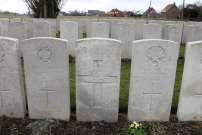| First Name: | Walter Jubilee | Last Name: | PETTIFER | |
|---|---|---|---|---|
| Date of Death: | 21/08/1917 | Lived/Born In: | Gray's Inn Road | |
| Rank: | Gunner | Unit: | Royal Garrison Artillery 21st Heavy Battery | |
| Memorial Site: | ||||
Current Information:34, Prospect Terrace, Gray's Inn Road Brandhoek New Military Cemetery3, Belgium
The exact circumstances of the death of Walter Pettifer on 21st August, 1917, are not known but artillery men faced many dangers and during the course of the war nearly 50,000 of them were killed. Their gun batteries were targeted by the enemy’s guns which accounted for many of their casualties. Others were sent forward to act as ‘spotters’ which meant going forward to the front line and signalling back to the guns necessary changes in target and other vital information. Keeping the batteries supplied with ammunition was a dangerous task as the enemy guns would target the known supply routes, especially at night. Brigade Diaries rarely shine any light on casualties sustained, unless of course they were officers and even then information is sparse. This was a campaign fought between July and November 1917 and is often referred to as the Battle of Passchendaele, a village to the north-east of Ypres which was finally captured in November. It was an attempt by the British to break out of the Ypres salient and capture the higher ground to the south and the east from which the enemy had been able to dominate the salient. It began well but two important factors weighed against them. First was the weather. The summer of 1917 turned out to be one of the the wettest on record and soon the battlefield was reduced to a morass of mud which made progress very difficult, if not impossible in places. The second was the defensive arrangements of concrete blockhouses and machine gun posts providing inter-locking fire that the Germans had constructed and which were extremely difficult and costly to counter. For 4 months this epic struggle continued by the end of which the salient had been greatly expanded in size but the vital break out had not been achieved. The Royal Garrison Artillery operated larger and less mobile guns than the Field Artillery. The most common weapon of the Heavy Batteries of the RGA were 60 pounder (5 inch) guns which were mainly used to destroy the opposition’s artillery as well as targeting strong-points, dumps, stores, roads and railways behind enemy lines. The first heavy batteries to reach the Western Front were attached to infantry divisions but by the middle of 1915 they were being transferred to Heavy Brigades that operated under the orders of individual Army Corps. The 21st Heavy Battery was in action during Third Ypres. |
||||
| « Back to Search Results | ||||
| If you think any of the information shown here is incorrect, Click Here to submit your amends and comments | ||||




